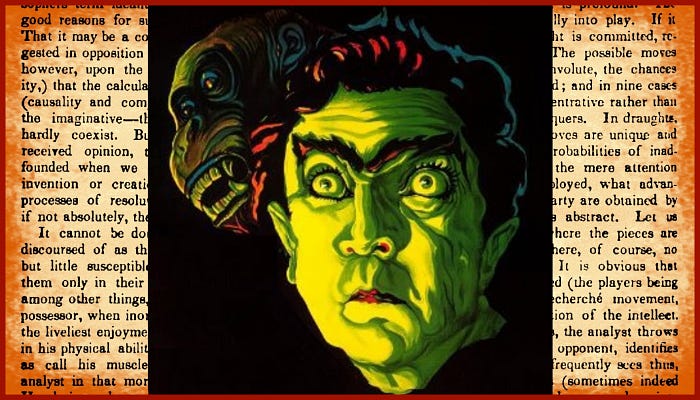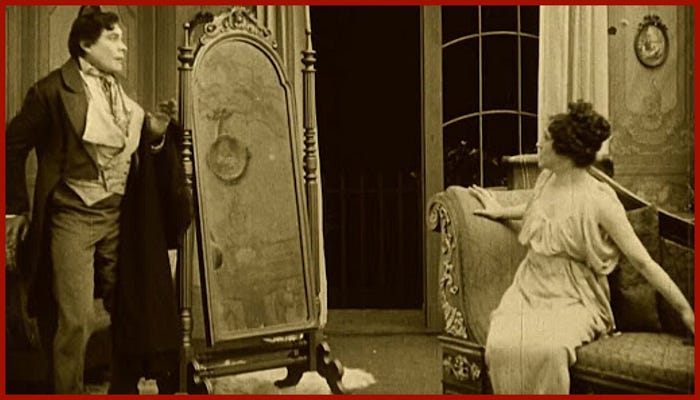The Students of Poe | Early Film Adaptations of the Master of the Macabre
By Sara Century

There have been entire articles about the difficulty or even impossibility of creating an Edgar Allan Poe adaptation that delivers the same impact of reading his stories. Yet, that is not to say that the attempt has not been made, often many times over with the same handful of “Terrifying Tales.” For all the many cinematic nods to Poe’s genius, the films made of his works are put in the position of padding out the plots of his exposition-heavy storytelling while attempting to modernize language and themes, and this is where things can so often go awry.
In the words of Roger Corman in regard to using Poe concepts only as the third act of a film and building a larger story around it, “a two-page short story is not about to give you a ninety-minute motion picture.” Still, the seemingly endless takes on Poe stories over the last many decades have, at different times, provided appealing aesthetics, genre-bending plots, incredible performances, and, of course, no small number of scares. Poe's film adaptations can be as far-reaching and strange as the author himself.

There are Poe adaptations dating just about as far back as film has existed, making him a writer who is in many ways synonymous with the history of cinema, despite having passed away nearly four decades before the shooting of the Roundhay Garden Scene and almost five before the advent of narrative movies. As such, there are more surviving silent film versions of Poe stories than one might think, including a few by some of the biggest names in film at the time.
In 1913, Alice Guy-Blache created a take on “The Pit and the Pendulum” that is considered to be lost save for its opening reel. It’s difficult to judge overall quality from an introductory clip, but Guy-Blache added plot details by fleshing out the personally motivated and highly unethical machinations of the Spanish Inquisition, pushing elements of social commentary. It is said that the production was a highly uncomfortable one. This is perhaps compounded by the fact that they used live rats, which apparently horrified lead actor Darwin Karr to the point of refusing to retake a shot, as well as the wildly brutal real-world deaths of the “excess” rats used in filming before the days of animal rights advocacy groups. D.W. Griffith had more than one foray into Poe’s repertoire, one a clunky biopic with essentially no facts in it about the writer’s life and the other a take on the “Tell-Tale Heart” (with overtones of “Annabel Lee”) in 1914’s The Avenging Conscience.


The Student of Prague is based on Poe’s doppelganger story, “William Wilson,” and is often considered the first independently produced film, as well as being considered the forebearer that helped kick off German expressionism. Amplifying the dreamy surrealism of the short story while simultaneously reimagining the context around its protagonist made this not only a huge financial and critical success but created a work that remains highly influential. Directed by and starring the pioneering Paul Wegener as a poor student named Balduin, a top swordfighter having fallen for a Countess, Balduin is desperate to think of new ways to achieve financial independence in order to rise above the class limitations that prevent him from pursuing his love. This leaves him wide open when a malicious mage offers to make him rich if he can take only one thing from Balduin’s apartment, shocking the young student by taking his reflection from the mirror. Using brand new double-casting camera tricks, The Student of Prague remains a haunting and fascinating reimagining of one of Poe’s strangest stories.
Another great silent film take is the feature-length The Fall of the House of Usher. Co-written by an early-career Luis Bunuel as well as being the film for which director Jean Epstein is best known, this is a surrealist masterpiece that is not to be overlooked. The story follows a man whose wife dies as he is painting her portrait, leaving him to mourn with her image hanging quite literally over his head. Despite straying significantly from the source material, this feature is easily as captivating as a Poe short and utilizes classic themes from his works, such as isolation in a scenic estate, tragic love, and the fear of being buried alive.


Going into the 30s and the horror explosion at Universal Studios that saved the company from bankruptcy with the surprise financial success of Dracula in 1931, the studio rushed to create more features starring various ghouls. Perhaps inevitably, this led to a number of Poe adaptations, including Murders in the Rue Morgue, The Black Cat, and The Raven, each of which featured Bela Lugosi while the latter two films also featured Boris Karloff, giving audiences a dramatic duo of two of the era’s most notable horror icons. Behind the scenes, Lugosi and Karloff may not have been particularly well-suited to work together, but any animosity worked well for their chaotic onscreen pairings. If you’re a fan of either actor, it’s worth sitting down with these takes, despite their incredibly tenuous connection to the Poe stories on which they are based.
The Universal takes are admittedly not the most memorable films, either in regard to Poe homages or the studio’s legendary monsters. The added elements are generally absurd, the dialogue can be seriously uncomfortable, and there’s an era-specific need to tag on a neat tidy ending regardless of whether or not it suits the story overall that can be grating. Yet, each of the directors involved managed to evoke gorgeous imagery, compelling performances, and spooky moments out of some fairly contrived scripts, and that effort is not for nothing. Though these films may not quite reach the heights of some later Poe alliterations, and though they are best-considered vehicles for entertaining, career-defining performances from Lugosi and Karloff, there is no denying that there’s a genuine lean towards the bizarre that makes each of these films unforgettable in their own right.
From the silents to the talkies, there were a number of cool, interesting Poe tributes that expanded the author’s legacy in some surprising ways. Going into the age of technicolor, that knack for flying off the rails was about to establish itself as the definitive characteristic of Poe adaptations in a very big way, as would the general tendency to add weird, wild aesthetics and innovative cinematography while keeping dialogue and character motivation in a more-or-less secondary role. 🩸
About
Sara Century is a featured writer for Manor Vellum. Sara is a horror writer, a critic, a reporter, a filmmaker, and an artist that has written for many publications and platforms. She is the co-host of the Bitches on Comics podcast as well as the co-founder and editor of the Decoded Pride anthology which focuses on works of queer speculative fiction.
Follow MANOR on Bluesky, Facebook, Instagram, Pinterest, Threads, TikTok, X, YouTube, and other sites via Linktree.
© 2021 Manor Entertainment LLC
